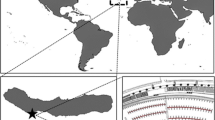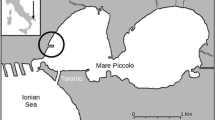Abstract
The amphipod Caprella californica is native to California, but is known from the Pacific coast of North America, Mexico, Chile, Japan, Hong Kong and South Africa. C. californica is able to raft on kelp (Morris et al. 1980), and has been recorded on man-made structures such as rafts, settlement ropes and biofouling prone assemblages on ship hulls. Of interest is the recent rapid expansion of Caprella californica in Australian waters from its first recorded sighting in Sydney Harbour in 2002, to several recorded sightings over the last 4 years at Cockburn Sound, Western Australia, Hobsons Bay, Victoria, and the Port of Cairns, Queensland.



Similar content being viewed by others
References
Arimoto I (1976) Taxonomic studies of caprellids (Crustacea, Amphipoda, Caprellidae) found in Japanese and adjacent waters. iii-229. Special publications from the Seto Marine Biological Laboratory. Series III
Ashton GV (2006) Distribution and dispersal of the non-native caprellid amphipod, Caprella mutica Schurin 1935. The University of Aberdeen, Old Aberdeen, pp 143–150
Australian Museum Business Services (2002) Port survey for introduced marine species-Sydney Harbour final report, pp 22–25
Caine EA (1977) Feeding mechanisms and possible resource partitioning of the Caprellidae (Crustacea: Amphipoda) from Puget Sound, USA. Mar Biol 42:331–336
Caine EA (1979) Functions of swimming setae within caprellid amphipods (Crustacea). Biol Bull 156:169–179
Caine EA (1987) Potential effect of floating dock communities on a South Carolina estuary. J Exp Mar Biol Ecol 108:83–91
Carlton JT (1979) History, biogeography, and ecology of the introduced marine and estuarine invertebrates of the Pacific Coast of North America. PhD Thesis. University of California, Davis, 904 pp
Cook EJ, Jahnke M, Kerckhof F, Minchin D, Faase M, Boos K, Ashton G (2007) European expansion of the introduced amphipod Caprella mutica Schurin 1935. Aquat Invasions 2:411–421
Hong J (1988) Amphipod crustaceans as fouling organisms in Tungnyang Bay, Korea. Mar Fouling 7:1–7
Keith DE (1968) Substrate selection and feeding in Caprellid Amphipods of Southern California, with emphasis on Caprella californica Stimpson, 1857 and Caprella equilibria Say, 1818. PhD Thesis. University of Southern California, 223 pp
Keith DE (1971) Substrate selection in Caprellid Amphipods of Southern California, with emphasis on Caprella californica Stimpson and Caprella equilibra Say (Amphipoda). Pac Sci 25:387–394
Kosman E (2002) The effect of the amphipod Caprella californica on the foraging behaviours and distribution of the nudibranch Hermissenda crassicornis in the mudflats of Bodega Bay and the role of size differences in the interspecific competition for space. Bodega Marine Laboratory, University of California
Montelli L (2006) Caprellidea (Crustacea: Amphipoda): an investigation into the environmental parameters that affect its distribution at three different sites. (report)
Morris RH, Abbott DP, Haderlie EC (1980) Intertidal invertebrates of California. Stanford University Press, Stanford, CA, 690 pp
Poore GCB, Storey M (1999) Soft sediment crustacea of Port Phillip Bay. In: Hewitt CL, Campbell ML, Thresher RE, Martin RB (eds) Marine biological invasions of Port Phillip Bay, Victoria, pp 150–167. Centre for Research on Introduced Marine Pest. Technical Report No. 20. CSIRO Marine Research, Hobart, 344 pp
Ruiz GM, Carlton JT, Grosholz ED, Hines AH (1997) Global invasions of marine and estuarine habitats by non-indigenous species: mechanisms, extent, and consequences. Am Zool 37:621–632
Sliwa C, Migus S, Hayes K, McEnnulty F (2003) Marine bioinvasions in Australia. CSIRO Marine Research, Australia, pp 1–19
URS Asia Pacific Pty Ltd. Biofouling of RAN ships and submarines: report supplement. Project No. 42905349-1892:R1204
Acknowledgments
The author would like to thank Anna Murray from The Australian Museum, for confirmation of C. californica. The author would like to thank Jim Dimas from DSTO for collecting samples from the raft at Hobsons Bay, and Joanne Wann from Fleet Base West, Wade Hoskins from DSTO Trinity Inlet for the retrieval of settlement ropes and the Bowson Port Services in Cairns. The author would also like to acknowledge the work done by URS and the divers involved in the collection of biofouling samples from Navy vessels.
Author information
Authors and Affiliations
Corresponding author
Rights and permissions
About this article
Cite this article
Montelli, L. The recent geographical expansion of Caprella californica (Caprellidea: Caprellidae) around the coastline of Australia. Biol Invasions 12, 725–728 (2010). https://doi.org/10.1007/s10530-009-9484-6
Received:
Accepted:
Published:
Issue Date:
DOI: https://doi.org/10.1007/s10530-009-9484-6




